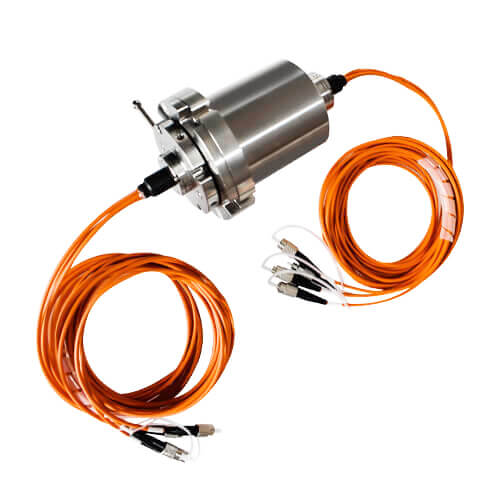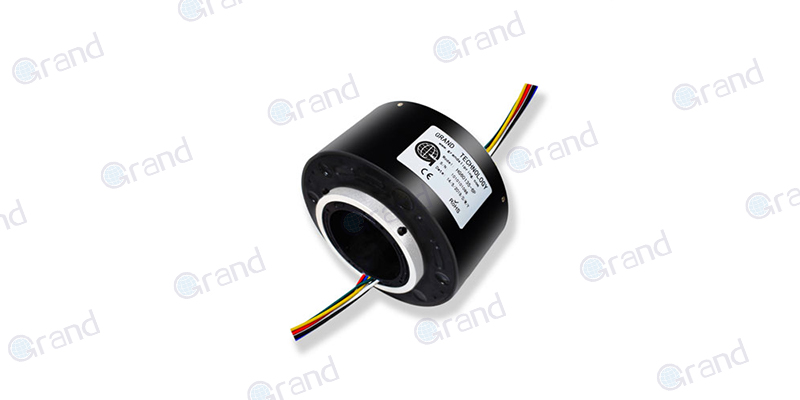Slip rings, often referred to as rotary electrical interfaces, rotating electrical connectors, collectors, swivels, or electrical rotary joints, serve as the critical interlinking technology between stationary and rotating systems. By facilitating the transmission of power and data signals, slip rings play a crucial role in sustaining the functionality of a myriad of systems across a plethora of industries. Whether it’s within heavy machinery, wind turbines, cable reels, test equipment, or even the production of electricity, the versatility of slip rings underscores their indispensability.
As we delve into the technicalities of this enigmatic component, the purpose of this article crystallizes; it’s written to serve as a comprehensive guide to understanding the principles of “slip ring law.” Despite being a focal point in numerous industrial applications, the nuances of slip ring technology often escape widespread comprehension. Demystifying this critical operational and design facet of slip rings is expected to provide engineers, technicians, students, and even hobbyists, with the knowledge and skills to optimize the functionality and efficiency of their rotating systems.
This article brings to the foreground not just theory but a practical perspective, drawing on insights from an industry professional who designs and manufactures slip rings in their day-to-day work. This coupling of theory and practice provides a well-rounded understanding that can align design, maintenance, and troubleshooting processes with the ‘slip ring law’ effectively. Therefore, this translates into a host of benefits for the readers, ranging from improved efficiency and effectiveness in their work, a deeper appreciation for the role of slip rings, to fostering innovative thinking for future improvements in slip ring technology.
Moreover, the expertise of an industry professional brings with it a certain discourse authenticity, amplifying the credibility of the insights, tips, and knowledge shared throughout the article. This evidence-based discourse is intended not only to instill a high level of trust in the reader but also corroborate the evidence-based practices recommended for dealing with slip rings.
By engaging with this article, readers equip themselves with valuable knowledge that can significantly enhance their understanding, usage, maintenance, and, ultimately, the performance of their slip ring systems. This expansive guide aims to serve as a comprehensive resource, from the exploration of basics, troubleshooting guidance, and looking at future trends. Expect to uncover essential yet often overlooked aspects of slip rings, as articulated by a seasoned industry professional.
Fundamentals of Slip Ring Technology
The functioning of a slip ring might seem complex, but the basic principle behind it is quite straightforward. Slip rings provide a simple and effective solution to an otherwise challenging problem: transferring electrical power or signals from a stationary structure to one that’s rotating, or vice versa. They primarily consist of rotating and stationary components commonly referred to as the rotor and the stator, respectively, with electrical connections typically made through brushes and rings. A continuous electrical pathway is established as the brush slides over the ring during rotation, facilitating uninterrupted power or signal transmission. This setup forms the core of all slip ring structures, albeit with numerous variations and customizations to suit different applications.
Slip rings, in their many manifestations, encompass a broad spectrum, each type championing specific advantages and bearing inherent disadvantages as well. For instance, traditional sliding contact slip rings offer the advantage of transmitting multiple signals simultaneously, but they have limitations in data rate and noise. Capacitive slip rings, on the other hand, can transmit high-speed digital data and are immune to electrical noise, but they might not be as effective with power transmission. There are numerous other types, such as mercury-wetted, fiber optic, wireless, or even hybrid slip rings, each uniquely suited to cater to specific needs dictated by the application involved.
Applications of slip rings are as diverse as their types, further accentuating the versatility of this component. One of the most common applications is in the field of wind energy generation involving massive wind turbines. Given the need for the turbine blades to rotate freely while maintaining electrical contact with stationary systems, slip rings prove essential. Other applications include electrical generators, packaging machinery, cable reels, rotary sensors, video surveillance systems, and even in the realm of space science in satellites and spacecraft. Moreover, advancements in slip ring technology are consistently pushing boundaries, opening doors for newer applications, and optimizing the existing ones.
Grasping the fundamentals of slip ring technology, from its basic operation, various types, advantages, and disadvantages, to its wide array of applications, lays the groundwork for the comprehensive understanding of ‘slip ring law.’ It also highlights the sheer importance of this component and its overall impact on the efficient functioning of countless mechanical and electrical systems across industries.
In-depth Explanation of Slip Ring Law
The ‘slip ring law’ is not a conventional law akin to the laws of physics, but rather a guiding principle or an empirical rule that governs the operation of slip rings. It essentially dictates that the efficiency, functioning, and longevity of a slip ring system are proportionally linked to how efficiently the electrical contact is made and maintained between the brush and ring under varying operational conditions.
A nuanced understanding of this law requires delving into the interplay between the law itself, the electrical contacts, and the efficiency of power transfer. In essence, the slip ring law stipulates that the better the electrical contact, the more efficient the transfer of power or emergency happens. Brush and ring materials, their relative pressure, speed of rotation, and surface condition significantly influence the quality of the electrical contact. This whole dynamic profoundly impacts the overall efficiency of the power transfer and thereby, the operational capabilities of the slip ring systems.
The factors affecting the slip ring law are multi-dimensional. The foremost among them is the contact resistance. As brushes make contact with the rings, the electrical resistance at the point of contact significantly influences the overall electrical efficiency. Brush materials, varying from precious metals to carbon composites, directly impact this resistance. A second pivotal factor is the surface conditions. Smooth and clean surfaces ensure optimal contact, reducing the resistance and enhancing the efficiency of power transfer. Conversely, surfaces prone to oxidation or contamination can complicate the connection, increasing resistance and degrading the system’s overall efficiency.
A keen awareness of the slip ring law is crucial during the design and selection phase of the slip ring system. Designers must ponder the electrical requirements, the environment, the expected lifespan, and the rotational speed of the system, keeping the principles of the slip ring law at the vanguard. The brush and ring materials should be carefully selected to have lower contact resistance, and measures should be taken to ensure the integrity of the surfaces.
Deepening one’s understanding of the slip ring law is an exercise in gaining mastery over the peculiarities and practicalities related to the transfer of power and signals in rotating systems. Recognizing how the slip ring law works – its relationships and influences – aids in better designing, maintaining, and troubleshooting slip ring systems, thereby elevating their performance and efficiency.
Slip Ring Law: Insights from an Industry Professional
Designing and manufacturing slip rings offer a unique vantage point from which to discern the intricacies of the slip ring law. As an industry professional, my journey in the realm of slip ring engagement has been one of constant learning, filled with hands-on experiences, breakthroughs, and solutions to seemingly unruly obstacles.
Ensuring optimal performance in slip rings while adhering to the slip ring law can often feel like a tightrope walk. The core strategy, I’ve found, involves valuing a deep understanding of the purpose and performance requirements of the application over generic specifications. For instance, choosing the right type of slip ring, be it a traditional sliding contact or a more advanced capacitive or wireless variant, is crucially dependent on whether the focus is on power transmission, data transfer, or a mix of both.
Contact resistance and wear-and-tear are omnipresent challenges faced in designing and operating slip rings. Through my experiences, I’ve learned that selecting a brush material with low-resistance characteristics and long-term durability is vital. But, beyond that, maintaining an optimal level of brush pressure and regularly cleaning the brush and ring surfaces often brings about significant improvements in performance and a noticeable reduction in wear.
The field of slip ring technology is constantly evolving, and staying up to speed with these advancements lends itself well to overcoming traditional challenges. For example, unconventional yet effective solutions to the wear-and-tear problem include the use of fiber optic slip rings, which replace conventional brushes and rings with beams of light for signal transmission, eliminating mechanical contact and consequently, the wear-and-tear related issues.

Moreover, advancements in manufacturing technologies like 3D printing now enable us to create custom slip ring components, opening the door to a whole new world of possibilities in slip ring design. This approach can help us design and manufacture slip rings specifically tailored to the unique needs of the application, thereby providing an effective solution to challenges presented by the slip ring law.
Being an industry professional doesn’t make me immune to the challenges posed by the slip ring law. Instead, it validates the need for resolution, innovation, and continuous advancements in technology in order to ensure the slip ring mechanisms continue to efficiently fulfill their purpose across various industries.
Slip Ring Law: Ensuring Compliance with Relevant Standards and Regulations
Compliance with established safety guidelines and industry standards is of paramount importance when dealing with slip ring systems. It not only ensures the safe operation of the equipment but also influences its overall performance, efficiency, and longevity. Furthermore, neglecting compliance can have grave consequences, including costly damage to equipment, voiding of warranties, and, in extreme cases, harmful accidents.
The regulations and norms pertaining to slip ring systems largely depend on the industry or application. For example, in defense and aerospace applications, slip rings need to comply with stringent environmental and electromagnetic compatibility regulations, as well as rigorous certification processes. In commercial or industrial contexts, standards laid down by institutions such as the International Electrotechnical Commission (IEC) or Underwriters Laboratories (UL), among others, set the benchmark for safety, performance, and reliability. These regulations are there to ensure that all the components, including slip rings, operate safely and can endure the respective operating conditions.

Users of slip ring systems should remain vigilant about the need for compliance. An essential tip for users would be to pay attention to the specifications detailed by the slip ring system manufacturers. Always ensure that systems are installed, operated, and maintained as per the manufacturer’s guidance. Manufacturers design these with compliance to all necessary standards and safety protocols in mind, and deviation from these guidelines could result in non-compliance. Another crucial aspect is the regular inspection and maintenance of the slip ring systems. Regularly checking the efficiency of electrical contacts, the condition of brushes, and the cleanliness of ring surfaces can not only improve performance but also prevent conditions that could lead to safety hazards.
In ensuring compliance, users inadvertently align their operations with the slip ring law, optimizing the performance and longevity of their rotating electrical systems. Thus, compliance is not simply a matter of conformance with safety norms, but also a strategic move towards improved operational efficiency and productivity.
Slip Ring Law: Maintenance, Troubleshooting, and Tips for Maximizing
The importance of regular maintenance, informed troubleshooting and optimization tactics concerning slip rings cannot be overstated, as these directly correlate with enhanced performance and longevity. Keeping slip ring law in mind, users must embark on a meticulous journey of understanding the system’s nuances to maximize its output while precluding the possibility of issues.
Best Practices for Routine Maintenance
Routine maintenance demands a proactive and consistent approach to ensure the optimal functioning of slip rings. These practices may include:
- Regular cleaning and inspection: Keeping the brushes and rings free from contaminants, dust, and dirt, and confirming smooth, unblemished contact surfaces.
- Monitoring brush wear: Over time, brushes exhibit signs of wear; timely replacement is crucial to avoiding damage to the rings or reduced performance.
- Verifying adequate brush pressure: Ensuring that brushes consistently maintain enough pressure on the rings for optimal electrical contact, while avoiding excessive pressure that may lead to premature wear.
Observing Changes and Early Issue Indicators
To preempt potential problems, users must remain attentive to subtle changes in performance or early warning signs. For instance, unusual noises or vibrations in the system, unexplained fluctuations in power or data transmission, or irregular temperature variations warrant immediate investigation and maintenance.
Troubleshooting Common Problems
When faced with slip ring issues, the first step in troubleshooting is to consult the manufacturer’s guidelines and thoroughly check the slip ring system for potential causes. Delving into the slip ring law may offer a better understanding and alignment with the issue at hand. Common problems include but are not limited to, fluctuating electrical contact, noise in signal transmission, or excessive wear. Troubleshooting may involve adjusting brush pressure, changing brushes or cleaning contact surfaces, and investigating the source of signal disturbances.
Optimizing Slip Ring Systems
To maximize performance and prolong the life of slip ring systems, users must consider adopting these optimization strategies:
- Select the appropriate slip ring type: Evaluate and prioritize performance requirements and operational conditions to choose the best-suited slip ring variant.
- Ensure proper installation: Align the slip ring system with the manufacturer’s recommendations; discrepancies in installation can hamper the performance and longevity of the system.
- Effectively manage the environment: Control factors such as dust, temperature, humidity, or vibration to maintain optimal slip ring conditions. In industries with harsh environments, consider slip rings explicitly designed to endure these conditions.
In conclusion, the synergy between diligent maintenance informed troubleshooting, and strategic optimization is indispensable in harnessing the full potential of slip rings, ultimately realizing their promise in terms of performance, reliability, and efficiency.
Future Trends and Developments in Slip Ring Law
Contemplating the future is essential in any field, and slip ring technology is no exception. There are numerous emerging trends, technologies, and material innovations shaking up the traditional paradigms of this space. These developments not only enhance the capabilities of slip rings but also offer solutions to age-old challenges.
Emerging Developments and Innovations in Slip Ring Designs and Materials
We observe a noticeable shift towards leveraging advanced materials and new design approaches in slip ring technology. For instance, the advent of fiber brushes has brought about significant improvements in power and signal transmission efficiency. Similarly, innovative designs where traditional solid metal rings are being replaced by hollow shaft structures, reduce weight, conserve space, and facilitate integration with other components.
Addressing Traditional Limitations with New Technologies
New technologies are providing solutions to overcome the traditional limitations of slip rings. For example, the introduction of contactless slip rings, such as capacitive or optical slip rings, eliminates contact resistance, wear-and-tear, and signal noise, thereby decreasing maintenance demands and enhancing reliability. Moreover, the integration of advanced sensor technology is enabling real-time monitoring and predictive maintenance, pushing the boundaries of system longevity and uptime.
Potential Impact on Various Industries
The evolution of slip ring technology profoundly impacts diverse industries by enhancing the capabilities of rotating systems. In the field of renewable energy, improved slip rings augment wind turbine performance and animal-friendly radar systems. Defense and aerospace sectors are also enjoying the benefits of ultra-reliable slip rings that can withstand harsh conditions and support mission-critical applications. In the era of digital transformation, advanced slip rings bear the promise of enabling high-speed data transfer to accommodate the explosive growth in data generation and communication needs.
In conclusion, the future of slip ring technology is indeed bright. Characterized by continuous innovation and dynamic adaptation to overcome traditional limitations, these evolving trends are propelling slip ring technology into a future that bridges the gap between the mechanical and the digital world. As we continue to explore and develop, we also continue to unravel the immense potential this ubiquitous component holds for various industries.
Conclusion
Understanding slip ring law unlocks new avenues for generating maximum efficiency and reliability from your slip ring systems. This comprehensive guide offers you an in-depth understanding right from the basics to the future of slip ring technology, fostering continued learning and innovation in this field. Embrace the insights and expertise shared by an industry professional to amplify the potential of your slip ring operations.
See What We Can Do

